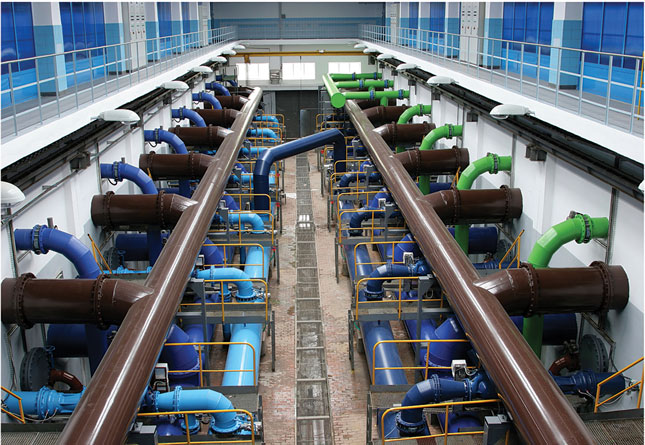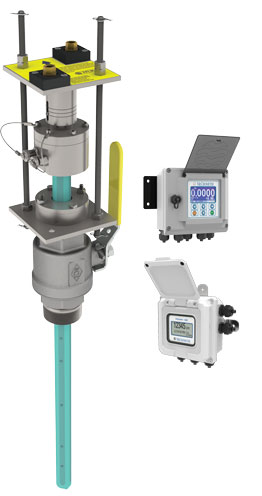Associate Product Manager, McCrometer, Inc.
Article | January 31, 2023
Download as a PDF document
 Municipal water and wastewater treatment systems present a challenging environment in which the accurate and reliable measurement of liquid flow is essential for cost-effective plant operation. In order for drinking water and wastewater effluent treatment systems to run as economically as possible, accurate flow measurement is necessary to ensure that limited clean water resources and treated wastewater effluent are processed efficiently.
Municipal water and wastewater treatment systems present a challenging environment in which the accurate and reliable measurement of liquid flow is essential for cost-effective plant operation. In order for drinking water and wastewater effluent treatment systems to run as economically as possible, accurate flow measurement is necessary to ensure that limited clean water resources and treated wastewater effluent are processed efficiently.
Standard liquid flow measurements are made with meters at multiple points as raw drinking water is pumped and moves forward from groundwater or other sources through canals or pipelines, into treatment facilities, into storage tanks and back out into distribution systems or receiving waters for wastewater treatment.
In some water systems, however, there is also a need to measure reverse flow or bi-directional flow (forward and reverse totalized flow).
No matter whether you are measuring forward, reverse or bi-directional water flow, choosing the flow meter best suited for the application will result in improved accuracy, repeatability, lowered maintenance costs and will promote a long-life for the flow meter. Not all flow meters provide bi- directional flow measurement capability, and it is important to identify the need for bi-directional measurement early in the instrument specification process.
Typical Problems That Require Bi-Directional Flow Measurement
Water Treatment Plants
Complex Piping Configurations:
In large and older treatment plants there are often complex plumbing configurations that have been retrofitted or expanded over time. In these situations the flow of water may be unknown or difficult to understand. A bi-directional flow meter allows plant engineers to get a complete picture of the total flow occurring in that location.
Multiple Pipe Inputs:
In some discharge applications, there may be two or more pipes combining into one flow. In these pipe configurations, high flow in one pipe can lead to reverse flow in another. Bi-directional flow measurement leads to a better understanding of the true flow in a network of pipes.
Water Distribution and Storage Applications
Water Selling/Sharing:
It is common practice for nearby municipalities to sell water to or share water with one another. In these cases, the water does not always only flow in one direction. Supply and demand changes between two locations mean that the water may need to flow in both directions. A bi-directional flow measurement allows the calculation of net flow between locations.
Multiple Water Sources:
As cities look to diversify their water sources, it is becoming more common to have multiple sources of water for one municipal plant. Multiple sources of water mean that water has the potential to flow in different directions, leading to a need for bi-directional flow measurement.
Ring Main Distribution:
In certain distribution configurations, the direction of water flow is designed to change based on real-time usage. Bi-directional measurement allows for the measurement of total flow in ring main distribution applications.
Storage Tanks:
Bi-directional measurement is required in order to calculate the net flow into and out of storage tanks.
Solution
Electromagnetic or “mag” meters can provide bi-directional flow measurement and are well suited for applications within water and wastewater treatment plants. They offer a number of advantages over other flow measurement technologies, including accuracy, repeatability, simple installation, ease of use, relatively low maintenance and long-life.
There are several different manufacturers of electromagnetic flow meters, and each has its advantages and disadvantages. For example, the FPI (Full Profile Insertion) Mag flow meter from McCrometer is designed for bi-directional flow measurement (Model 394L).
It solves complex measurement problems that occur where water may flow in both forward and reverse directions through the same pipe
Bi-directional meters, such as the FPI Mag, provide a totalized measurement through the adding and subtracting of liquid flow, allowing for net flow calculations. The meter, which is calibrated for forward and reverse measurement capability, offers technicians the ability to carefully monitor flow in complicated situations with a factory-programmed converter/transmitter. The meter is available for service in line sizes from 4 to 138 inches and compares well to the performance of full bore electromagnetic flow meters and when calibrated with either the ProComm or ProComm GO converter it has a a highly stable profile providing accuracy as follows:

- AC or DC power: ±0.5% of measured value ±0.006 ft/s (±0.0018 m/s)
- Battery power: ±1% of measured value ±0.006 ft/s (±0.0018 m/s)
- Reverse Flow: ±1% of measured value ±0.006 ft/s (±0.0018 m/s)
All mag meters, including the FPI bi-directional meter, operate under the principle of Faraday’s Law of Electromagnetic Induction to measure water velocity. The principle of operation states that a conductor such as water, moving through a magnetic field, produces a voltage, the voltage is directly proportional to the velocity of the water moving through the field.
This FPI meter’s unique streamlined sensor features multiple electrodes across the entire pipe diameter. Electrode pairs are located so each pair measures an equal cross-sectional area. The velocity measurements are added and averaged, providing an area-weighted average velocity across the pipe’s centerline. Flow is then calculated by multiplying the average velocity by the cross-sectional area of the pipe.
Multi-electrode sensing provides accurate measurement without long upstream and downstream pipe runs. The multi-electrode sensor design compensates for variable flow profiles, including swirl, turbulence and low-flow conditions. Multiple electrodes placed across the entire sensor body continuously measure and report the average flow rate over the full diameter of pipe for greater accuracy and repeatability.
With its full profile insertion design, the FPI Mag flow meter provides performance comparable to full bore mag meters. This design approach accommodates hot tap installation and reduces installation costs by more than 45 percent as compared to conventional full bore meters. The savings is achieved by eliminating the need for heavy equipment or extensive manpower. Installation can occur without interrupting service, dewatering lines, cutting pipe, or welding flanges, making the FPI Mag a highly economical solution for medium and large line sizes.
The meter’s compact insertion design fits easily into confined spaces with limited access and offers total accessibility. It is particularly cost-effective for retrofit applications replacing existing flow meters or in sites never metered before.
The meter utilizes a pre-programmed plug-and-play converter with a six point curve-fitting algorithm to improve accuracy. The converter offers a 4-20mA (1000 ohm) analog output and a RS485 port for easy connection to DCS. It includes an easy-to-read 8 line graphical display and 3 key touch programming. Its rugged enclosure meets IP67 requirements.
Mag meters in general are intelligently designed and offer a highly stable flow sensor with no moving parts, containing nothing to wear or break, and are generally immune to clogging by sand, grit or other debris. The sensors come pre-calibrated from McCrometer’s own NIST traceable calibration lab and require no recalibration in the field.
Conclusion
In some cases, bi-directional flow measurement is essential to determine the movement of water through a pipe or plant system. Not all flow meter technologies are suitable for bi-directional flow measurement, and for those that have this capability, it can be a challenge to specify a model. In general, mag meters, including those designed by McCrometer, are available in bi-directional flow measurement configurations which provide excellent accuracy.
The new Model 394L bi-directional FPI mag flow Meter in particular offers a number of advantages. With a full-profile insertion design, this meter simplifies installation by eliminating the need for extensive shutdowns, cutting the pipe, etc. Its multi-point sensor array ensures accurate measurement across the full diameter of the pipe, which is especially important where variable flow conditions exist. Combining accuracy, ease-of-use and a low total installed cost, operators will find this mag meter helps them better manage their plant operations bottom-line.

